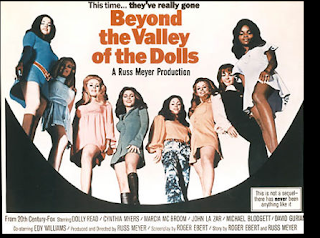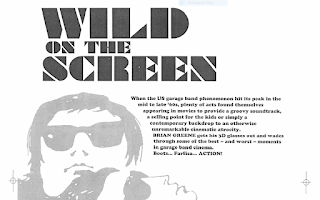My Top 10
Publications to Date
Since 2008, approximately 175 of my short stories, personal
essays, and feature articles on books, music, and film have been published, in
28 different outlets. I thought it might be time to take a moment and
reflect on all of this work, focusing on some of the more satisfying
publications.
Being a freelance writer has brought me a wide spectrum of
experiences. Some assignments have come off smoothly and exactly how, or even
better than, I hoped they would. Others have not gone well at all, for a number of reasons. And some have come out pretty well in the end but weren’t a lot of fun during the process. It’s nice to stop for a second and
think about some of the better experiences.
In doing my journalism pieces I have become acquainted with
many interesting people. It would be hopeless to try and remember all of them.
Musicians, people who work for record labels or who handle publicity for the
artists and the labels; writers and people who work for publishing companies;
filmmakers and actors . . . and of course the editors of the publications for
which I’ve written. I’ve interviewed some musicians I greatly admire – Roky
Erickson, Sky Saxon, Bernie Worrell, among others – as well as one of my
all-time favorite people from the history of cinema: Mimsy Farmer. I’ve had one
running column via which I’ve been able to write extensively about a cherished
literary genre – noir fiction – and another one that gave me the opportunity to
cover a collection of people/outfits who work in independent music releases, an
endeavor I value greatly.
Ok, enough preface. Following are 10 publications that stand
out to me as the most fulfilling assignments I’ve worked on to date:
Mimsy Farmer
Shindig! magazine of
the U.K. is a publication for which I have written roughly 40 feature articles,
in addition to numerous reviews. They are a music magazine specializing in
covering underappreciated/outsider pop/rock/psychedelic/folk/soul, etc. music
from the 1960s and ‘70s. At one point they were looking to expand their
coverage of relevant film subjects, and when this came about, I immediately
thought of one of my favorite cult movie people: actress Mimsy Farmer. I
tracked Farmer down on the web and arranged a phone interview with her; this
chat was easily the most interesting and enjoyable interview I’ve ever done
with an artist. My article on Farmer was published in Shindig in 2009, and, at a later date, parts of it
were excerpted in the British Film Institute’s Blu-Ray/DVD reissue of the movie More, in which Farmer stars.
(note:
Shindig is a hard copy publication that does not post content to the web as a rule, thus no links to my pieces for them)
The Notes
“The Notes” is a short story that I originally wrote many
years back. In 2008 I revised it to enter it into a short fiction contest held
by the Jerry Jazz Musician web site. JJM is an online culture magazine that
covers things like classic jazz music and literature, and they hold a quarterly
short story competition. “The Notes” won their competition in the summer of 2008.
link to the announcement and story
Lost Classics of Noir
Macmillan
Publishing’s Criminal Element blog has been my biggest publishing outlet mainstay
in recent years. I have written 72 pieces on crime fiction and crime and cult
films for them. Criminal Element’s focus is crime/suspense fare, on
TV, in literature, in the movies, in comic books, etc. and in everyday life. I have had, and
continue to have, an enjoyable working relationship with them. About one third
of the pieces I’ve done for the site up to this point comprise a series called
Lost Classics of Noir, in which I write appreciations of worthy, undervalued
works of edgy crime fiction.
link to all of my pieces for Criminal Element
Ted Lewis
Ted
Lewis was a groundbreaking and influential crime fiction writer from England,
who wrote mostly in the 1970s. He authored the novel that is the basis of the
acclaimed film Get Carter. Lewis is a
hero to many noir fiction aficionados, but far from a household name, even
within the broader world of crime fiction and the people who follow the genre.
I did extensive research on Lewis’s life and work and wrote several articles on
him, for a variety of publications and from a variety of angles. The piece I
did on him for Criminal Element – my inaugural article for the site – is the
one that best sums up the end results of all my research.
link to the post
Garage in the Movies
In 2009, Shindig! produced a special
issue/paperback book, called Psychotic
Reaction, that focused on American garage music made in the 1960s. I contributed
three features for this release, and one of those was one of the more enjoyable
and satisfying projects I’ve worked on thus far: I wrote a feature on American
garage bands who had scenes in cult and camp movies from the era.
Susan Jacks
This one goes back to 2004. Susan
Jacks is a Canadian vocalist who was once a member of the psychedelic pop group
The Poppy Family, along with her then-husband Terry Jacks. The Poppy Family are
a band I love, and I knew they were also appreciated by the editor of the music
magazine Scram, for which I was doing
some writing at the time. I arranged to interview Jacks for Scram and the piece went up on the
publication’s web site. Even though it is only a Q&A piece with a very
brief intro by me, and thus not a thorough work of journalism as are most of my
feature articles on artists, this one stands out to me because I thought Jacks’s
answers to my questions were interesting and because, to my knowledge, there
was no other article in existence at the time in which Jacks reflected on her
career and her time with The Poppy Family.
link to the interview
George
V. Higgins
Mulholland Books is a crime fiction
publisher that also runs a webzine. In 2011, I wrote a piece for their site on
American crime fiction author George V. Higgins. Higgins’s first novel, The
Friends of Eddie Coyle, is one of the finest and most lasting works of edgy
crime fiction, and it’s far from his only worthy book. I wrote a
rundown of Higgins’s literary work, focusing on his belief in using an unusually
high amount of dialogue in his novels. I got an enormous amount of positive
feedback about this one.
link to the piece
Malcolm
Braly
A little earlier this year, I
contributed an article on American noir writer Malcolm Braly to the Literary
Hub web site, which is run by Grove/Atlantic. Braly was a man who spent
most of his adult life in prison, and who wrote his first novel, and most of
his second, from behind bars. In this article I focused on how his life as a
con impacted his efforts as an author. This project stands out for me because
it was my first for Literary Hub, which has one of the larger reading audiences
for which I’ve written. I hope to do
more pieces for them in the future.
link to the post
What’s
in a Label?
In 2011, Shindig! started a new regular column called What’s in a Label?,
each installment being a profile of an independently-run music label that
produces releases of interest to the magazine’s readership. I was assigned to
write the first of these and I did it on Seattle, Washington’s taste-making
reissue label Light in the Attic. After this, the editors asked me to make this
column my own. Other writers for the magazine eventually penned some of the
installments, but I wrote the first 10 or so, and ultimately did 12 of them. I
covered indie reissue labels from all over the world and who released lost gems
from a variety of music genres. I think the best of my What’s in a Label
columns was that first one, on Light in the Attic.
John
Trinian
John Trinian was a San
Francisco-based writer who penned a series of high-quality, grossly overlooked
novels in the 1960s, most of them in the noir vein. His 1964 title Scandal on the Sand is one of my favorite
works of fiction, by anybody in any genre. Trinian was also an intriguing, ne’er-do-well
kind of man in his daily life. I wrote a feature article about his life and
work, some of this content coming about via a phone interview I did with his
daughter. This feature will appear in a book anthology of writings about
beatnik and pulp literature, called Beat Girls,
Love Tribes, and Real Cool Cats: Pulp Fiction and Youth Culture from the 1950s
to the 1980s. The book will be published by Verse Chorus Press this fall.

















































